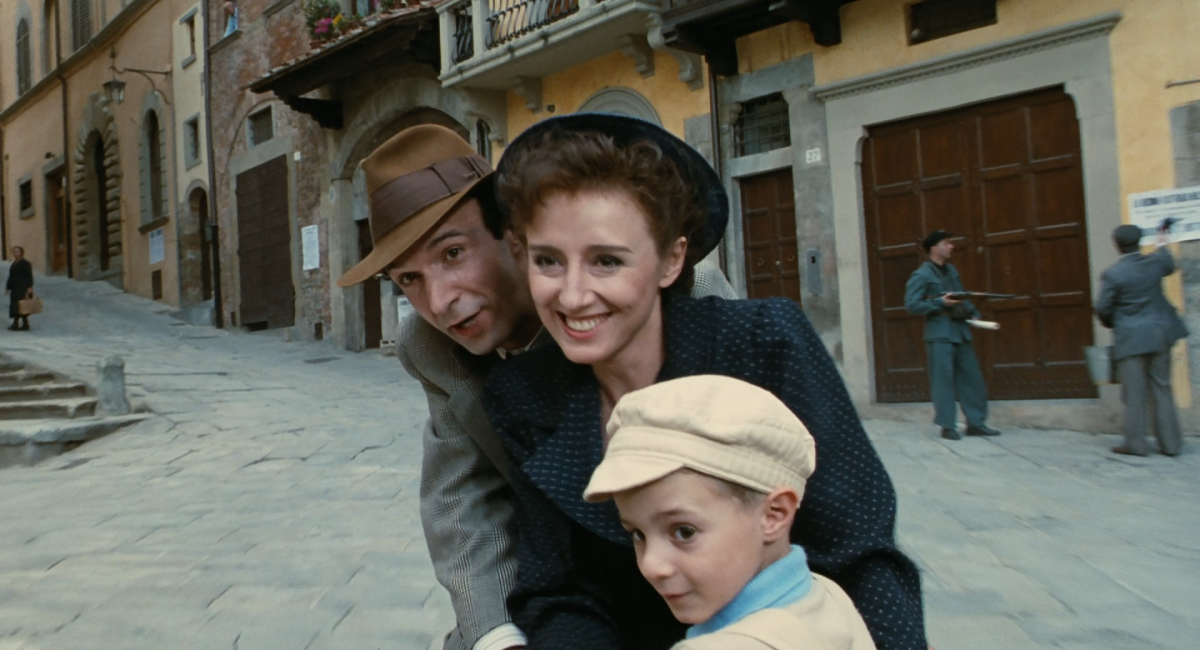‘Genres do not consist only of films: they consist also, and equally, of specific systems of expectation and hypothesis which spectators bring with them to the cinema, and which interact with films themselves during the course of the viewing process. These systems provide spectators with means of recognition and understanding’ (Neale, 1990: 46).
What Neale is stating is that upon recognising the genres exhibited in a film spectators are able to delineate how the film may function ideologically as the narrative unfolds. This is due to a knowledge and understanding of the systemic similarities that underscore films in any given genre. Thus, certain expectations are attached to certain genres, so comedy would be associated with a light-hearted viewing experience.
La Vita e Bella tells the story of a man’s pursuit of love and the lengths that he must take to protect his family as the ensuing implications of the holocaust threaten to strip away their idyllic lives.
In the film’s first half the filmic world is established as audiences recognise ‘why the characters are dressed the way they are, why they look, speak and behave the way they do’ (Neale, 1990: 46) in regards to genre. In this case elements such as Guido’s outlandish behaviour notify audiences to the comedy genre. Slapstick humour is born out of energetic, physical sequences, such as the running motif of Guido inadvertently cracking eggs over Dora’s husband’s head.
Romantic themes are inscribed almost to the extent of a fairy-tale. When Guido first meets Dora she falls to him from a tower, harkening back to stories like Rapunzel, and upon falling in love with her he plots to save her from her oppressive husband-to-be. The scene in which Guido takes Dora for a drive sees her dress tear into a more enticing outfit and a red carpet be laid out in front of her, reminiscent of the carriage and subsequent transformation of Cinderella. Of course the most overt reference is that throughout Guido refers to Dora as ‘princess.’
As the narrative progresses in the second half so do the implications of the holocaust and very abruptly the generic images shift to present that of the war drama genre. In fact all the idyllic imagery, bright-lighting and colour palette and joyful characters are abandoned. All that remains from the first half is Guido and his son, who are stripped of their usual warm attire and dressed in a prison gowns. This sudden shift in generic image enhances the audiences’ shock and fear for the characters as it subverts the optimistic ideology set in place in the first half. Then the tragedy of Guido’s death is made all the more devastating to the spectator due to these ideological expectations.
However, as the mantra of the film details in its opening title cards, ‘like a fable there is sorrow and, like a fable, it is full of wonder and happiness’ (La Vita e Bella, 1997) and this concept is upheld in the ultimately positive resolution, which sees Joshua survive due to the efforts of his father. Guido’s character enforces consistent tones of comedy through his animated behaviour and witty dialogue, contesting the harsh reality of their captors and the sorrow perpetuated by the war/drama genre. Guido purposefully mistranslating the Nazi’s threats to Joshua to make him laugh could be seen as allegorical to the purpose of the comedy genre, perpetuated by Guido, serving to manipulate the audience’s expectations, be it to subvert and imbue sorrow (Guido’s death), or to achieve and imbue happiness (Joshua’s survival).
Similarly to the consistency of comedy through Guido’s character in Bella, Kaboom (20allocates subordinate characters to certain genres. For example, Lorelei is adamantly characterised as a witch, her all-black costume connoting that of the iconic witch, and thus attributes of the horror genre are introduced through her scenes. In Kaboom this device is used as a means of interjecting a barrage of specific genre images into a scene to poke fun at the systemic ideology of the coming of age/teen-comedy genres, as the expectations alluding to what that genre should offer, as in Bella, are subverted.
Bibliography
Kaboom, 2010 [Film]. Directed by Gregg Araki. USA: Desperate Pictures.
Neale, S. (1990) ‘Questions of Genre’ in R. Stam and T. Miller (eds) Film and Theory An Anthology. Columbia.edu, pp. 157-178 [Online].
La Vita e Bella [Film]. Directed by Roberto Benigni. Italy: Melampo Cinematografica


One thought on “Roberto Benigni’s ‘La Vita e Bella (Life is Beautiful)’ – A Brief Study on Genre”